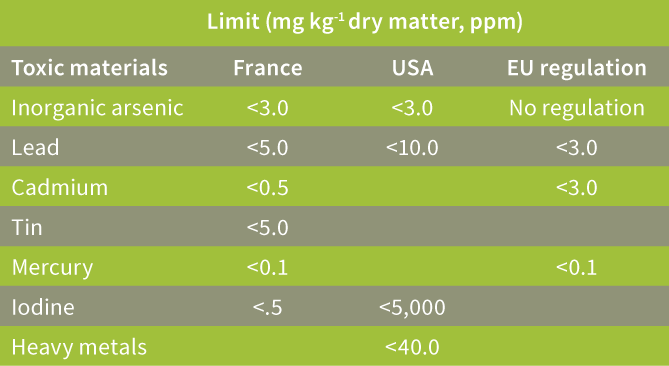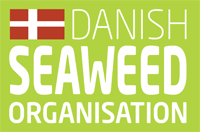REGULATION OF HARMFUL COMPONENTS
Seaweeds are generally known as high in concentrations of minerals like mentioned in the previous paragraph. Seaweeds are really good as biofilter, accumulating minerals from the ambient environment. However, if heavy metals are present, these will also be accumulated (Holdt and Kraan, 2011). Furthermore, the large brown kelps (such as Saccharina latissima) are known for large quantities of iodine, and some (especially species of Sargassum e.g. Hiziki) are high in total and inorganic arsenic, where the latter is the harmful chemical (Holdt and Kraan, 2011). Therefore, there are some attention related to heavy metals, inorganic arsenic and iodine. The thresholds in regulations are given in Table 3. The EU regulation is regarded to the use of seaweed for dietary supplement, whereas France and USA have regulations regarding the use of seaweed as food. Furthermore, the EU regulation is not covering all compounds such as inorganic arsenic and iodine, and please notice that the regulations of France and USA are very different e.g. regarding iodine threshold concentrations. The chemical risk assessment should therefore take all regulations into account when evaluating the use of seaweed as food in Denmark (or EU).
Table: Quality criteria applied to edible seaweed sold in France, regulations in the USA and for dietary supplements in EU.

Source: Other references in Holdt and Kraan, 2011
Written by Susan L. Holdt (for FAO), based on The National Danish Food Authorities/Fødevarestyrelsen- link: http://www.foedevarestyrelsen.dk/Leksikon/Sider/Tang-som-foedevare.aspx and presentation. Download here (in Danish).
References:
Holdt, S.L., Kraan, S. (2011). Bioactive compounds in seaweed: functional food applications and legislation. Journal of Applied Phycology, 23, 543-597
Lüning (2008) Integrated macroalgae-oyster aquaculture on a north sea island: seasonal productivity of the brown alga Laminaria saccharina and the red algae Palmaria palmata; Solieriachordalis, Gracilaria vermiculophylla, and the use of these seaweeds in human nutrition or as raw material for the cosmetics industry. 11th International Conference on Applied Phycology, Galway, Ireland. June 22–27
Mouritsen, O.G., Dawczynski, C., Duelund, L., Jahreis, G., Vetter, W., Schröder. M. (2013) On the human con-sumption of the red seaweed dulse (Palmaria palmata (L.) Weber & Mohr), J. Appl. Phycol., vol. 25:6, pp. 1777–1791.
Written by Susan L. Holdt (for FAO), based on The National Danish Food Authorities/Fødevarestyrelsen- link: http://www.foedevarestyrelsen.dk/Leksikon/Sider/Tang-som-foedevare.aspx and presentation. Download here (in Danish).
References:
Blue biomass (2016). Blå biomasse – potentialer og udfordringer for opdræt af muslinger og tang. DTU Aqua-report no. 312-2016 (in Danish). Petersen, J.K., Bjerre, A-B., Hasler, B., Thomsen, M., Nielsen, M.M., Nielsen, P. pp. 39.
Holdt, S.L., Kraan, S. (2011). Bioactive compounds in seaweed: functional food applications and legislation. Journal of Applied Phycology, 23, 543-597
Lüning (2008) Integrated macroalgae-oyster aquaculture on a north sea island: seasonal productivity of the brown alga Laminaria saccharina and the red algae Palmaria palmata; Solieriachordalis, Gracilaria vermiculophylla, and the use of these seaweeds in human nutrition or as raw material for the cosmetics industry. 11th International Conference on Applied Phycology, Galway, Ireland. June 22–27
Mouritsen, O.G., Dawczynski, C., Duelund, L., Jahreis, G., Vetter, W., Schröder. M. (2013) On the human con-sumption of the red seaweed dulse (Palmaria palmata (L.) Weber & Mohr), J. Appl. Phycol., vol. 25:6, pp. 1777–1791.
Seaweed as food in DK (2016). Regulation regarding seaweed as food and for the trade in Denmark, The Ministry of Environment and Food of Denmark –https://www.foedevarestyrelsen.dk/Leksikon/Sider/Tang-som-foedevare.aspx (in Danish; accessed Nov 2016)
